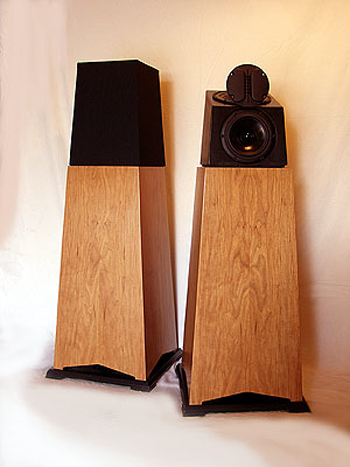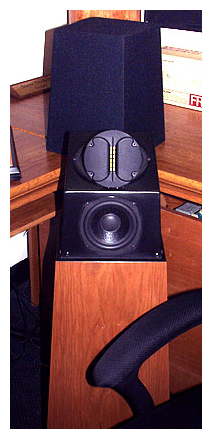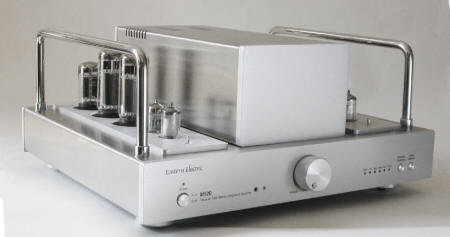You are reading the older HTML site
Positive Feedback
ISSUE
22
decware
RL3.0 loudspeakers
as reviewed by John Mazur

|
JOHN MAZUR'S SYSTEM
LOUDSPEAKERS
ELECTRONICS
SOURCES
CABLES
ACCESSORIES |
Reality TV sucks. I cannot believe what the networks will do to chase advertising dollars. What slays me even more is that people are willing to prostitute themselves for the networks. Still, if you have been following my reviews, you have been reading a "reality" Positive Feedback of sorts.
It all started last year, when I jettisoned my Magneplanars because I was searching for speakers that weren't so room dominating. The reality part of it comes from the fact that I have used my own money to procure the candidates. Therefore, I am beholden to no one. There is no advertising to protect, no favors to return, and no friends' products to promote. I have ruffled some feathers in the process, but I have no apologies. The reviews offer my real emotions and decisions, which are the same as those of any customer spending hard-earned money. The Decware RL3.0 speakers are the third ones I have evaluated. The first two were the Decware RL1.5s and The Horne Shoppe Horns.
 The RL3.0s are a fairly
recent addition to the Decware stable. They are the combined effort of Steve
Deckert and Bob Ziegler. They have the same omni-directional radiation pattern
as the RL1.5s, as well as the passive radiators at the bottom of the cabinets
and the Hi-Vi ribbon tweeters. The RL3.0s add front-firing drivers. Their build
quality is first-rate. Even the shipping crates are well built. The customer has
a choice of wood veneers and of internal wiring. The pair I evaluated had a
eucalyptus veneer.
The RL3.0s are a fairly
recent addition to the Decware stable. They are the combined effort of Steve
Deckert and Bob Ziegler. They have the same omni-directional radiation pattern
as the RL1.5s, as well as the passive radiators at the bottom of the cabinets
and the Hi-Vi ribbon tweeters. The RL3.0s add front-firing drivers. Their build
quality is first-rate. Even the shipping crates are well built. The customer has
a choice of wood veneers and of internal wiring. The pair I evaluated had a
eucalyptus veneer.
I had a hard time getting a fix on these speakers at first. I was able to plop down the Decware RL 1.5s and get them singing without much fuss, but when the First Watt F1 amplifier showed up, the RL1.5s were transformed. I couldn't hold back my emotions. It just wasn't like that with the RL3.0s—it took a good deal of work to get them positioned. They needed to sit a little further out into the room, and I had to sit a little further away. Once I resolved the placement issues, I settled on the First Watt amplifier as the best match for the RL3.0s. The First Watt, a current-source amp, had better speed and resolution than the other amps I own.
The first thing I heard was that the RL3.0s were more fleshed-out than their little brothers. The RL1.5s are more distant, the RL3.0s more forward and intimate. The 3.0s' images were more rounded, their perspective more front-to-back, and they sounded warmer. Bass was also deeper and fuller. However, I could not get rid of some low-end overhang that was especially apparent on acoustic bass. I tried any number of resistors across the speaker terminals to try to improve the damping characteristics of the F1 amp. I finally found 15 ohms to be the best, but even with the 15-ohm resistors in place, the speakers were still too bass-heavy. When I talked to Steve Deckert about it, he said that the problem was uncommon, but does happen in some rooms. To take care of it, he offers foam inserts of differing densities to place underneath the passive radiators. When the bass meets the customer's approval, Steve sends the passive radiators that correspond to the compliance of the chosen insert, and the customer returns the original passive radiator. This corrected the bass prominence in my room.
If speakers can't rock, I am not interested. I appreciate jazz and classical music, but the speakers should damned well rock. I like it loud! The 3.0s did the job. They have speed, speed, and more speed, along with loudness. I was not surprised to hear that Steve Deckert is a drummer after hearing how well drums sounded. Drum kits were more pronounced than any I have heard. I could hear the skin impact and the subsequent resonance. Drums just sounded more like drums. This added much-needed drive to rock recordings. On ZZ Top's Tejas, Frank Beard sounded like he could put his fist through the floor toms. Creed had better intelligibility with the 3.0s than with the 1.5s, and considerably more than the Maggies, which were not good on rock, at least in my system. I enjoyed playing the Decwares LOUDLY, without strain or distortion. Elton John's recording of "All the Girls Love Alice" sounded raucous, caustic, and haughty, all at the same time. The 3.0s were able to portray the intentions of the recording engineer, along with the emotional content of the music.
Female voices are another of the 3.0s' strong suits. I'll spare you the Diana Krall descriptions, but Mary Stallings' Fine and Mellow had convincing height, good focus, and seductiveness. The accompanying saxophone also had a seductive, rounded sound. I was very impressed by the Mapleshade CDs. If all Redbook CDs sounded this good, we wouldn't need SACDs. Cymbals were reproduced with good extension and shimmer.
I do not own many classical CDs, as I find that I get bored with them. I may not buy much classical music, but I do listen to it on the radio, and I support the local college stations—all two of them. The 3.0s' portrayal of orchestral music was impressive. They had the ability to transform the front of the room into the performance venue. I found myself stuck in my chair, enthralled by the music. I could tell violas from violins, and all sounded truthful. Choral recordings had good scale and weight. I have never been much of a pipe organ fan, but what I heard on the "Pipe Dreams" radio program changed that. The 3.0s were able to make my walls disappear, and create a huge acoustic space for the organs to perform in. I was transfixed.
The point at which I really got excited, however, was when I heard the Eastern Electric M520 integrated tube amp on the 3.0s (read Fown-Ming Tein's review here). The night before the M520 arrived, my son and I attended The Australian Pink Floyd Show, a must-see experience for Pink Floyd fans. The cover band was so faithful to the material that I had a hard time convincing myself that it was not Pink Floyd. When we arrived home after the concert, I tried to recreate what we had heard by playing several Pink Floyd CDs, but it just wasn't happening. I gave up, and assumed that a "mere" stereo could not do what I wanted.

When I put the M520 into service the next evening, I was not prepared for what I heard. I wasn't sure what music to try, so I put on the SACD of Dark Side of the Moon. I was in complete awe after three cuts. I had heard this record many times, but never like this. When I cranked the volume, it sounded like the previous night's concert. Synthesizers were swirling, guitars soaring, and drums crashing. After shaking off my disbelief, I ran upstairs to get my son. The music put a big smile on his face, and he spoke enthusiastically about the sound. We had a great deal of fun reliving the experience of the concert. THIS is what I call the absolute sound.
Roger Waters' In the Flesh, a live SACD, came even closer to recreating the experience of the concert. There was so much power in the performance that I thought the amp must put out much more than 24 watts! The amp and speakers conveyed so much color, texture, and speed that it was hard to stop listening. The allure of the 3.0s and the M520 was similar to that of the RL 1.5/First Watt combination in its ability to draw me into the music, with head nodding and foot tapping. With the 3.0/First Watt combination the music appealed more to my intellectual, analytical side. With the M520, however, the sound was transformed into a tapestry infused with color and power. I came away from the Pink Floyd session with a beaming smile and ringing ears. Reality TV? This was more like Monster Garage or American Chopper.
The Decware RL3.0s convey every aspect of sound, from subdued to raucous. They can throw a three-dimensional soundstage without limiting the sweet spot to a narrow window. I don't miss the Maggies. The 3.0s let you hear what the upstream components are doing, don't cost a kings' ransom, and look great. They also look less like speakers and more like fine furniture. Because they did so many things so well, I voted with my wallet and kept them. They will be part of my system for some time to come. They rock! John Mazur
-
Specifications: 4 ohm nominal, 94dB 1W/1M - 2 @ 100 watts RMS
-
Frequency response: +/- 2dB 40Hz @ 20kHz -6dB @ 20Hz/25kHz
-
Dimensions: 14.5" x 14.5" x 39" H/with grill = 43", 40 lbs.
RL3.0 loudspeakers
retail: $1995/pair
Decware/High Fidelity
Engineering Company
1202 N.E. Adams Street
Peoria. IL 61603
TEL: 309. 671. 2428
web address: www.decware.com
Eastern Electric
Morningstar Audio Imports
44 E. University Drive
Arlington Heights, IL 60004
TEL: 847. 255. 1150
web address: www.morningstaraudio.com
The Australian Pink Floyd
Show
web address:
www.aussiefloyd.com
